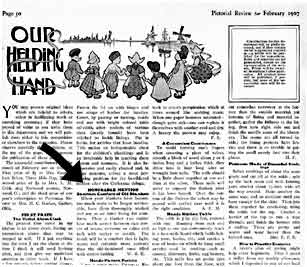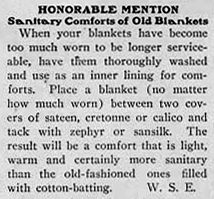 
|
 
THE MUSEUM OF MENSTRUATION AND WOMEN'S HEALTH
"Sanitary Comforts of Old Blankets," washable menstrual pad
tip in magazine contest, 1907
A visitor to the site kindly sent this page from the February 1907 issue
of the American magazine Pictorial Review. A contributor to that magazine,
W.S.E., won honorable mention for "Sanitary Comforts of Old Blankets"
in a monthly contest, seemingly for housewives, for the best household tip.
First prize that month went for "The Useful Alarm Clock," which
relates how the writer uses an alarm clock in her kitchen to time her oven.
Great idea! Other contributions are "Petticoats Made of Discarded Stockings,"
"Handy Pattern Pockets," and "How to Practice Economy,"
tips for brides. The contest looks like a Hints from Heloise for the early
20th century.
The contributor's grandmother gave her the magazine, and told her that
a comfort "was a pad for menstruation, just a nicer way of saying it."
Grandmothers know these things. I've added the expression to the "Words and expressions about
menstruation."
In 1907 probably most American women wore washable pads for menstruation,
for which Sears and other companies sold holders and belts (see examples
from 1902 and 1908). Successful disposable pads
didn't take off in America until Kotex (see its first
ad), in the early 1920s, although there were predecessors (see an example). Commercial tampons didn't appear until
the late 20s or early 30s (see one of the first),
although I have a reliable report of a German woman sewing - that's sewing
- her homemade tampons around 1900. Menstrual cups seem to have become commercial
in the 30s, although at least one patent for one appear in the 19th century
(see it and later cups).
But I have a theory: some - many? most? - American bled into their clothing
in the 19th century and before, just as most of their European (and African?)
forebears apparently did. Read more about this.
|
|
|
Below: the top of the household tips page from Pictorial Review, February
1907. The arrow points to the paragraph at left.

The figures dressed in Dutch costumes, above, probably refer to the
belief that the Dutch were good housekeepers. This idea again appears in
Old Dutch Cleanser, an American scouring powder from the mid-20th century
back to at least the 1920s. See a 1920s ad for
it.
Lower left: The rules for the contest, which appear in the box at upper
right in the page above.
|
© 2002 Harry Finley. It is illegal to reproduce or distribute any
of the work on this Web site in any manner or medium without written permission
of the author. Please report suspected violations to [email protected]
|
|






